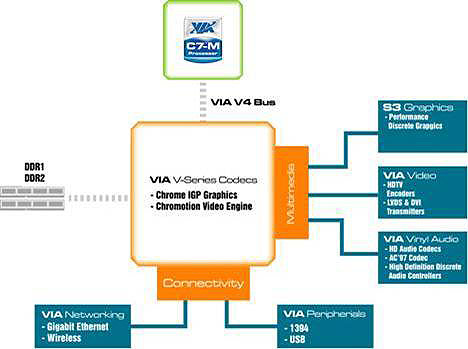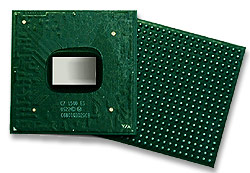 Like Intel and AMD, VIA has opted to use a cryptic naming scheme
for its mobile processors, divorced from any practical subjects like processor speed.
Let's take a look at the initial release of the tiny C7-M
series:
Like Intel and AMD, VIA has opted to use a cryptic naming scheme
for its mobile processors, divorced from any practical subjects like processor speed.
Let's take a look at the initial release of the tiny C7-M
series:
C7-M 795: 2.0GHz, 533MHz bus
C7-M 785: 1.8GHz, 533MHz
bus
C7-M 765: 1.6GHz, 533MHz bus
C7-M 754: 1.5GHz, 400MHz bus
All processors here are built with the 90nm SOI
manufacturing process, and the NanoBGA2 packaging mentioned above. Future
versions of the VIA C7-M will migrate to an 800MHz bus, though VIA has not mentioned anything
about speed grades above 2.0GHz.
Chipsets for the VIA C7-M
Processor
 Unsurprisingly, only VIA is currently making chipsets
for the VIA C7-M processor. It currently has three initial offerings:
Unsurprisingly, only VIA is currently making chipsets
for the VIA C7-M processor. It currently has three initial offerings:
VIA VN800: This chipset will feature FSB
speeds of 400MSHz, 533MHz and 800MHz with support for both DDR and DDR2
memory. It will use VIA's Unichrome Pro
graphics processor with MPEG 2 decoding support.
VIA VN600:This chipset will also feature FSB speeds
of 400MSHz, 533MHz and 800MHz with DDR and DDR2 RAM support. The Unichrome Pro
graphics adaptor is again featured, this time with a DVI output and
TV-out. Other Additions are SATA support, HD audio courtesy of VIA's Vinyl
audio.
VIA VN600-M: Same as the VN-600 with the addition of
HDTV-out abilities and MPEG 2/4/WMV9 acceleration.
VIA seems to be consciously working to compensate for
the weaker aspects of the VIA C7-M processor by integrating certain features into
the above chipsets. The addition of MPEG acceleration and the
capable VIA Vinyl audio codec to the capabilities of the processor should make
for much more well-rounded and multimedia capable ultra-light notebooks. Sadly,
none of the above chipsets support PCI Express in any way, shape or form.
While this is irrelevant in the current laptop market, the same is unlikely
to be true in a few months time.
An Interesting Dark
Horse
VIA's desktop chipset business has been on the decline
for a while, and the companies previous lines of processors have caused barely a
ripple in world markets. Unfortunately, low power consumption and heat are not a
primary concern of most desktop computer consumers and the C3-M mobile processor
was just not powerful enough to compete with other mobile processor
alternatives.  The VIA C7-M shares its
predecessor's excellent thermal and power characteristics, but it might
just be powerful enough to become a VIAble third option for notebooks in
which battery life and portability is a major concern.
The VIA C7-M shares its
predecessor's excellent thermal and power characteristics, but it might
just be powerful enough to become a VIAble third option for notebooks in
which battery life and portability is a major concern.
The Padlock co-processor's
security and encryption features are interesting, but not particularly
applicable to most consumer applications (except for the NX bit technology). In
certain business environments or in a more paranoid future though, they may
latch on well enough to become standard features in other company's
processors. We'll be interested to see how and if the Padlock speeds up
applications using RSA and IPSEC encryption.
The VIA C7-M's tiny size and thermal capabilities will
definitely help it's chances in the laptop market, though the lack of PCI
Express support in VIA's chipset lineup will not. As things appear now, look for
VIA
C7-M CPUs to appear in ultra-portable and budget laptops near you before the end
of the year. As we said earlier in the article, Transmeta's demise has left a
hole in the laptop market which VIA seems well-positioned to fill.
Find out about this and many other reviews by
joining the Weekly PCstats.com
Newsletter today! Catch all of PCstats latest hardware reviews right here.
Related
Articles
Here are a few other
articles that you might enjoy as well...
1. Athlon64 3700+ Overclocking Fun
2. The Underclocking Experiment
3. Technology Behind Dual Core CPUs
4. Intel Pentium 4 540 (3.2E) Socket LGA 775 Processor Review
5. AMD Athlon64 3500+ Overclocking Adventure
